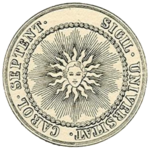- North Carolina Agricultural and Technical State University
-
North Carolina A&T
State University
Motto Mens et Manus (Latin) Motto in English Minds and Hands Established 1891 Type Public Land Grant Endowment US $13,330,712.40 Chairman Franklin McCain Chancellor Harold Martin Students 12,000 Location Greensboro, North Carolina, United States
36°04′31″N 79°46′25″W / 36.075352°N 79.773628°WCoordinates: 36°04′31″N 79°46′25″W / 36.075352°N 79.773628°WCampus Urban
200 acre (0.8 km²) main campus,
492 acre (1.99 km²) agricultural campusFormer names The Agricultural and Mechanical College for the Colored Race, The Agricultural and Technical College of North Carolina Colors Aggie Blue Gold Nickname Aggies Mascot Bulldog Affiliations Mid-Eastern Athletic Conference (MEAC) Website www.ncat.edu North Carolina Agricultural and Technical State University (NC A&T or A&T) is a land-grant university located in Greensboro, North Carolina, United States. It is the largest publicly funded historically black college (HBCU) in the state of North Carolina.
NC A&T is a constituent institution of the University of North Carolina System. It is accredited by the Southern Association of Colleges and Schools (SACS) and classified as a research university with high research activity by The Carnegie Classification of Institutions of Higher Education.[1] Founded in 1891 and known then as The Agricultural and Mechanical College for the Colored Race.
NC A&T is one of the nation's leading producers of African-American engineers with bachelor's, master's and doctorate degrees.[2] NASA is one of the major partners of the School of Engineering. It is also the nation's top producer of minorities with degrees (as a whole) in science, mathematics, engineering and technology.[2] NC A&T is also a leading producer of minority certified public accountants, landscape architects, and veterinarians.[citation needed] NC A&T offers 116 bachelor's degrees, 54 master's degrees, and doctorate degrees in energy and environmental studies, Leadership Studies, and mechanical, electrical, and industrial engineering. NC A&T is a member school of the Thurgood Marshall Scholarship Fund.
Contents
History
The North Carolina Agricultural and Technical State University was established as a "mechanical college" for the "Colored Race" by an act of the General Assembly of North Carolina, ratified March 9, 1891.[3] The act read in part: "That the leading objective of the college shall be to teach practical agriculture and the mechanic arts and such learning as related thereto, not excluding academic and classical instruction." This college was established along with North Carolina Agricultural and Mechanical College, now known as North Carolina State University; due to segregation laws, whites and blacks could not attend college together. The college operated in Raleigh at the private Shaw University until 1893, when donations from Dr. Dewitt, C. Benbow and Charles H. Moore totaling $11,000 and 14 acres (57,000 m²) of land allowed the establishment of a campus in Greensboro. The original course of study of A&T included languages and literature, mathematics, business, agriculture and military science. Female students enrolled from 1893 until 1901, but not again until 1928. In 1915, the name of the College became The Agricultural and Technical College of North Carolina by act of the NC General Assembly.
Presidents & Chancellors President Term John O. Crosby 1892–1896 James B. Dudley 1896–1925 Warmoth T. Gibbs 1955–1960 Samuel D. Proctor 1960–1964 Lewis C. Dowdy 1964–1980 Cleon F. Thompson* 1980–1981 Edward B. Fort 1981–1999 James C. Renick 1999–2006 Lloyd V. Hackley* 2006–2007 Stanley F. Battle 2007–2009 Harold L. Martin Sr. 2009-current *denotes Interim Chancellor On February 1, 1960, four A&T freshmen helped spark the civil rights movement in the South. Ezell Blair (Jibreel Khazan), Joseph McNeil, Franklin McCain, and David Richmond "sat-in" at an all white eating establishment (Woolworth's) and demanded equal service at the lunch counter. Because of their great desire for change and equality they inspired many other students of the university to join them in their non-violent protest to desegregate Woolworth's lunch counter. By the end of July 1960, their mission was accomplished and they became the A&T Four and their campaign became known as the Greensboro sit-ins.[4] Seven years later, the college gained university status and became North Carolina Agricultural and Technical State University.
On February 25, 2009, Chancellor Stanley Battle announced his resignation, effective June 30, 2009, citing family and personal issues.[5] The following month, on May 22, 2009, Dr. Harold L. Martin Sr. was elected as the 12th chancellor of the university by UNC System Board of Governors.
Academics
North Carolina A&T State University comprises six Schools and two Colleges:
- College of Arts & Sciences
- College of Engineering
- School Of Agriculture and Environmental Sciences
- School of Business & Economics
- School of Education
- School of Technology
- School of Nursing
- School of Graduate Studies
Campus
The main campus is spread out over 200 acres (0.81 km2) and is just nine blocks from downtown Greensboro. The campus is divided into three zones which contain administrative, classroom, and residence halls.
North Campus
The area known as North Campus provides Traditional, Suite, and Apartment style living options for students residing on campus. North Campus residence halls include: Cooper Hall, Alex Haley Hall, and The Aggie Village. North Campus is also home to such buildings as The Memorial Student Union, Aggie Stadium, and Corbett Sports Center. This area also houses various academic buildings for students majoring in Business, Communications, English, Political Science, History, Math, Dance & Theater, Biology, as well as other disciplines in the School of Business, Economics, and The College of Arts and Sciences.
East Campus
This area provides Suite, and Apartment style living to students. East Campus residence halls house facilities offering single, double, and private room environments. The residence halls on East Campus are: Pride Hall, The Aggie Suites, and Aggie Terrace. The residence halls are in close proximity to Corbett Sports Center, and the fitness and wellness center. East Campus houses various academic buildings for students affiliated with The School of Business and Economics, Air Force & Army ROTC, Education and Animal Science. East Campus also houses Dowdy Administrative Building and the Office of Student Admissions.
South Campus
South campus is home to the more historic building on campus. South campus residence halls provide Traditional community living. The residence Halls of south campus include: Barbee, Curtis, Holland, Morrison, Morrow, and Vanstory Halls. South campus is also home to Bluford Library, The College of Engineering, Williams Cafeteria, the Dudley Building (University Art Gallery),the Holland Bowl, the Fraternity and Sorority Plots, also known as "Greek Lane," as well as Sebastion Health Center.
Transportation
City Transit
The Greensboro Transit Authority (GTA) offers public bus service throughout the city of Greensboro. NC A&T is served by Route 10 - East Market Street (Monday - Saturday) and Route 22 - E. Market Street/Bessemer Avenue/Phillips Avenue (Sundays). The GTA also offers a service called Higher Education Area Transit, or HEAT. This service links downtown attractions to area colleges and universities. Students from eligible institutions are allowed to ride HEAT fare-free with a valid school identification card or HEAT issued farecard. NC A&T is served by Routes 70 (East Heat), 75 (A&T Heat) on weekdays and also Route 70/71 (East West) on evenings and weekends.
On Campus Transit
The campus also has its own transportation service called The Aggie Pride Shuttle. The shuttle travels to various stops on campus and contains two routes: The Blue Route and The Gold Route. Each route services a different half of the campus. The Memorial student union serves as the transfer point between the two routes.
Athletics
Main article: North Carolina A&T AggiesNorth Carolina A&T's Athletic program is classified as Division I by the NCAA. The athletic program offers 6 varsity sports for men and 9 for women. North Carolina A&T fields teams in: Baseball, Basketball, Football, indoor/outdoor Track & Field and cross country for male athletes. NC A&T also fields teams in Basketball, Bowling, Softball, volleyball, indoor/outdoor Track & Field, Tennis, cross country, and Swimming for female athletes. The school athletic teams are called the Aggies or Lady Aggies. Cheerleading is offered as the only co-ed sport at the university. The Aggie cheer squad are multiple time MEAC champions in both all girls and co-ed division cheerleading. The university participates in the Mid-Eastern Athletic Conference (MEAC) in all varsity sports. The Aggies Football program participates in the NCAA Division I Football Championship Subdivision (FCS).
The current athletic director for the university is Mr. Wheeler Brown. Brown became the director of athletics for North Carolina A&T on August 11, 2008. Before returning to his alma mater in 2002, Brown held the positions of assistant athletics director and assistant men’s basketball coach at Wheeling and Jesuit University. Brown played for the Aggies football team from 1974–78, and graduated from N.C. A&T in 1979 with a degree in health and physical education. Brown, a native of Baltimore, Maryland, was a part of N.C. A&T’s first MEAC football championship in 1975. Brown was an all-conference performer at offensive tackle for the Aggies and was inducted into the N.C. A&T Hall of Fame in 2003.





